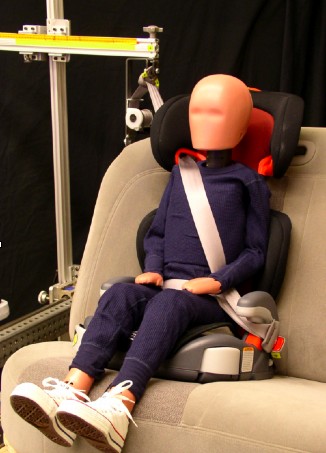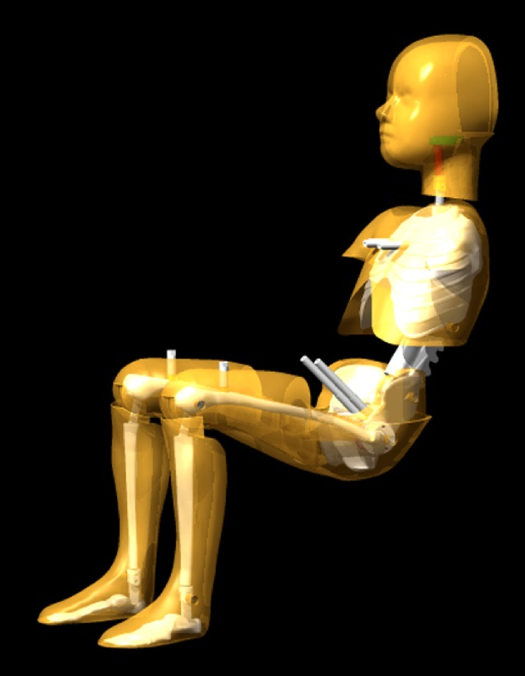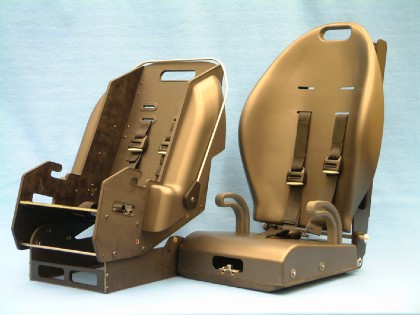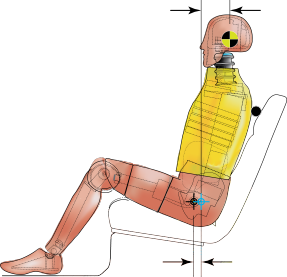>>> Research: Crash Protection for Vehicle Occupants
Tools for Safer Vehicles
My vehicle safety research has emphasized the development of tools that can be used to assess injury risk or to test restraint system performance. I've worked on a number of surrogates that represent humans for restraint system development, including crash dummies. I participate in UMTRI's basic biomechanics research involving post-mortem human subjects, but most of the safety-related projects I lead incorporate data from live volunteers in one form or another.
Child Passenger Safety

Motor vehicle crashes are the leading cause of death for children in the U.S. and many more children sustain injuries in crashes that lead to lifelong disability. Our research on child passenger safety focuses on improving the performance and ease of use of harness restraints and belt-positioning boosters. We have conducted studies of child anthropometry, posture, and belt fit, and applied the results to the development of improved procedures for positioning crash dummies. The limitations of current crash dummies are a major impediment to improved child restraints, and we are addressing those issues through the development of new specifications for dummy skeletal components based on anaysis of medical imaging data. [More..]
Occupant Classification Anthropomorphic Test Devices (OCATD)

Vehicles certified for sale in the U.S. are required to have front-passenger airbag systems that either suppress deployment when a child is present or deploy in a "low-risk" manner. Some of the occupant classification systems used to determine whether the front passenger seat is occupied, and the characteristics of the occupant, rely on pressure sensors in the seat. The OCATD project was initiated by the Alliance of Automobile Manufacturers to develop two new surrogates, representing a small adult female and a 6YO children, for testing these systems. Similar size crash dummies lack the flexibility needed for testing unusual postures, and the seat surface pressure distributions produced by the crash dummies differ from typical human pressure distributions. We developed the anthropometric specifications for the 6YO OCATD and assisted First Technology Safety Systems, the OCATD developer, in the application of UMTRI's AMVO data to the small-adult-female OCATD. We also conducted a detailed study of the pressure distributions produced by human occupants (children and adults) in a wide variety of postures. A parametric analysis of these pressure data was used to develop design specifications for the OCATDs and to validate their performance.
Head Restraints

Federal Motor Vehicle Safety Standard (FMVSS) 202 was recently revised to require higher head restraints that lie closer to occupants' heads. The new FMVSS 202a uses the Head Restraint Measurement Device to quantify backset, a measure of the fore-aft position of the head restraint. In response to the Notice of Proposed Rulemaking, we conducted an analysis of the likely effects of the rule on driver accommodation. We used data from several laboratory and in-vehicle studies to show that the proposed backset requirement would result in head restraints that interfered with the preferred head positions of a substantial fraction of drivers. As seats have been developed to meet the new requirement, manufacturers have petitioned NHTSA for reconsideration, citing driver complaints. My colleague Matt Parkinson and I have applied our optimization-based vehicle layout methodology to propose a novel approach to seat design that could reduce customer complaints by maintaining a constant backset distribution across driver-selected seat back angles. The figure (click for a larger image) illustrates a new measurement procedure we have proposed that would improve on the measurements provided by the HRMD.
Seat Belt Fit and Donning
We have conducted a number of studies on belt fit and belt donning. In work supported by Transport Canada, we developed belt-fit test components for the ASPECT manikin. To validate that tool, we conducted a laboratory study of belt fit using a wide range of belt configurations. The 68 study participants included 30 men and women who were obese. The data quantify the effects of belt geometry on both objective belt fit with respect to the skeleton and subjective ratings of belt fit comfort. We have gathered similar data from a smaller range of test conditions with children sitting in booster seats. As part of a larger study of driving posture, we also quantified belt donning tactics through video analysis. Drivers are much more likely to grasp the belt initiallly with the left hand than with the right hand.
Surrogate Child Restraints for Airbag System Testing

FMVSS 208 requires that vehicles for which the passenger airbag suppression option is chosen demonstrate compliance using any of two dozen or more child restraints listed in Appendix A of the rule. Concern for the complexity of testing with so many restraints led the Alliance of Automobile Manufacturers to sponsor a program to develop a family of surrogate child restraints. We made detailed measurements of over three dozen child restraints to develop design criteria. The surrogates, which we developed with our partner First Technology Safety Systems, represent a rear-facing infant restraint with or without a base, a forward- or rearward-facing convertible, a high-back belt-positioning booster, or a backless booster.
Airbag-Induced Skin Injuries
Airbags introduce energy to crashes beyond the kinetic energy in the colliding vehicles and their occupants. When occupants are close to airbags as they deploy, the high forces generated by the interaction with the airbag can cause a wide variety of injuries, ranging from low-severity abrasions to fatal head, neck, and chest injuries. My research has focused on the low-severity range of airbag-induced injuries, particular skin abrasions and thermal burns. Using experiments with human volunteers, we showed that airbag-induced skin abrasions result primarily from normally directed impact of airbag fabric, rather than a scraping action. We developed a laboratory test procedure using pressure-sensitive film to quantify abrasion potential. Airbag thermal burns result from skin contact with either the hot gas used to inflate the airbag or with module components heated by the gas. Over the course of several research projects, we quantified the sensitivity of human skin to short-duration, high-velocity, high-temperature gas jets. We developed a computational model of the heat transfer into the skin and the resulting burn injury. The burn model can be used in conjunction with simulation data or a laboratory test procedure to assess the skin burn potential of airbag designs. The movie shows the distribution of heat transfer to the skin during impingement by a round gas jet.
Crash Dummy Positioning

Conventional procedures for positioning crash dummies are not based on data or validated models of occupant posture. For most tests, the midsize-male crash dummies are tested with the seat at the middle of the fore-aft adjustment range. Small-female dummies are tested full-forward, and large-male dummies with the seat full rearward. We recognized that the occupant posture and position research that we have conducted could be used to create positioning procedures that would place the dummies in the most likely postures for similar-size occupants. The procedure is based on the seating accommodation model that is used in SAE J4004 to establish seat track lengths and positions. Working with the Insurance Institute for Highway Safety, we developed a robust procedure for testing in the driver's position. IIHS uses this procedure for frontal and side-impact testing. We have also developed a positioning procedure for rear seats that is based on measurements of passenger postures in vehicles and laboratory mockups.
©2024 Matthew P. Reed and The University of Michigan